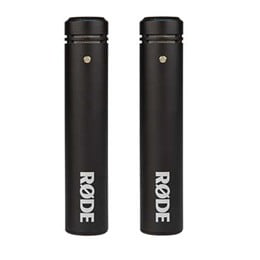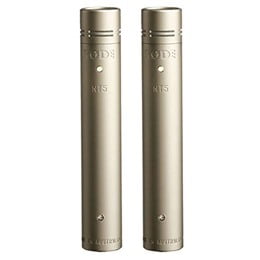Whether you’re recording ambient sound, a choir, a single instrument, or an orchestra, these compact condenser microphones may be just what you need. They will help make rich and clear recordings in the studio or during live performances. Let’s look at both mic sets and see which one is best for you.


Rode M5 Matched Pair Compact 1/2-Inch Condenser Microphones
Often called pencil mics, thesecan be used as a pair in a stereo array or individually. RODE certifies that as a pair they have not more than 1 decibel of sensitivity difference between them. They do just as well recording voices as they do percussion and string instruments. They can withstand a sound pressure level of 140 decibels, plenty for most live performances.
The M5s have a directional pickup pattern that grabs sound in front of them in a wide frequency range between 20Hz and 20kHz. They ignore sounds to the sides and rear. If they’re being used in wind, they don’t have a low-cut filter, but they do come with wind shields. Their self-noise is 19dB so they don’t get in the way of the recording with buzzing or humming. Their output impedance is 200 ohms, so they work with longer cables and still record higher frequencies well.
Power options for the MP5 mics are limited to 24 or 48-volt XLR connected phantom power. The output connectors are gold-plated for better conduction and purer signal transmission. The half-inch capsule also has a gold-plated membrane. The low self-noise comes from the surface-mount electronics and lack of transformers. RODE used their experience with the more-expensive NT5 mics and created the M5 as a superior option for their price range.
More features of the RODE M5 microphones
- 1-year warranty, up to 10 years with registration
- Come as a certified matched pair
- Box includes wind shields and stand mounts
- Each mic weighs a little than 3 ounces, measures0.87 inches in diameter and 3.94 inches long
- Ceramic matte-black coating over an all-metal housing
- Cardioid polar pattern
Rode NT5 MP Condenser Microphones for Drum Set, Matched Pair
With their nickel-plated housings, these NT5 microphones are a little larger and heavier than the M5 pair described above. They pleased lots of recording artists before RODE created the M5s as a less-expensive option.
The NT5s have small diaphragm condenser mics in half-inch capsules. The capsule is gold-sputtered which makes it conduct better but still retain rigidity. Like the MP5s, their pickup pattern is directed toward the front so they reject sounds from the sides and rear. (But note that their capsule is interchangeable with an omnidirectional capsule also available from RODE.)
These mics have a lower self-noise of just 16dB and a lower output impedance of just 100 ohms. This means they record higher frequencies well even when used with longer cables. They withstand a maximum sound pressure level of 143dB without distortion, higher than the M5s, and that’s one of the reasons they’re often seen recording percussion instruments.
Like the M5s, they need 48-volt phantom power to operate. They have XLR connectors and need an input with at least 100 ohms or more impedance in order to avoid signal loss.
More features of the RODE NT5 MP microphones
- 1-year warranty, up to 10 years with registration
- Come as a certified matched pair
- Satin-finish nickel-plate housing
- Weigh 3.56 ounces and measure 4.65 inches long (half an inch more than the M5 mics)
- Box includes with stand mounts and wind shields
- Stand mounts are compatible with 3/8” and 5/8” threads
Recommendation
These two sets of microphones are similar in many features and can be used for the same types of recordings, both in the studio and live on stage. Both can be used in stereo arrays or individually.
The M5 mics are a less expensive alternative to the NT5 pair. Some users have reported that they don’t notice a difference in the quality of the recordings between the two models. If you want quality pencil condenser mics with less cost, go with the M5.
The NT5 microphones have the advantage of lower self-noise and lower impedance, and they can withstand a higher sound pressure level, so they perform better in both the studio and with live events. If you’re recording either loud performances or soft ambient sounds, these may be the better choice for you.
Click here to purchase Rode M5 on Amazon!
Click here to purchase Rode NT5 on Amazon!